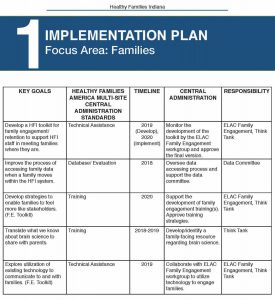In a featured blog series about strategic planning, we highlighted when to create a strategic plan and the 4 steps of strategic planning, including detailed blogs for each step (Step 1, Step 2, Step 3, Step 4). But what happens once you’ve completed those steps? Too often we find that organizations get stuck with figuring out how to take the big picture elements in the strategic plan and make them operational. To avoid this, we create an “implementation plan” during Step 4. This implementation plan unpacks the strategic plan into actionable steps for staff, committees, and the board, who are most likely responsible for implementation. By creating this more detailed implementation plan, your organization has a road map for how it will accomplish the goals identified in the strategic plan.
 On one of many strategic planning projects, we worked with Healthy Families Indiana (HFI) to help them develop their strategic plan, including the creation of a detailed implementation plan. We helped them implement the plan and still provide project management support for their Think Tank. The following five components are key pieces of any implementation plan.
On one of many strategic planning projects, we worked with Healthy Families Indiana (HFI) to help them develop their strategic plan, including the creation of a detailed implementation plan. We helped them implement the plan and still provide project management support for their Think Tank. The following five components are key pieces of any implementation plan.
Essential Components to Implement Your Strategic Plan
Strategies/Goals: It is important to include any priorities and goals set within your strategic plan in your implementation plan. For example, one of HFI’s key goals from their strategic plan is to translate information about brain science to share with parents. Including this goal in the implementation plan ensured they had a detailed plan to achieve it.
Measurable Metrics: Metrics to track progress toward a goal might be written within the original goal, but we have also seen the need to include this level of detail as its own column in the implementation plan. Metrics should be SMART – specific, measurable, attainable, realistic, and timely. Metrics help staff monitor success towards and impact of the strategic plan.
Action Steps: The implementation plan will spell out action steps to help your organization meet each strategy/goal. The tasks associated with the HFI goal included developing or identifying a family-facing brain science resource to share with parents.
Timeline: The implementation plan will indicate which year you plan to complete each task. For example, if you have set a three-year strategic plan, it is important to evenly schedule tasks out over those three years. For example, HFI determined that in their long-term schedule, developing and/or identifying family facing brain science resources would fit best within 2019.
Responsibility: The implementation plan should indicate who is responsible for completing each task. Identifying those responsible helps ensure accountability and track progress. The responsible party could be a group or individual, such as staff, board members, or a committee. HFI identified the Think Tank as the most appropriate group to complete the task outlined in the previous components.
Tips for Using Your Implementation Plan
- When carrying out an implementation plan, it is important to establish a procedure to track progress on tasks. For example, we’ve done this for clients by creating a spreadsheet they can update every quarter to track their actions.
- An organization can update its implementation plan over time if needed. Tasks may take longer or shorter than anticipated, so it is appropriate to update timelines as you go.
At TCG, we are privileged to work with organizations at all stages of the strategic planning and implementation process. We have helped many other clients through their strategic planning and implementation process. Check out a success story here.
Once you have set the strategic vision for your organization, it is time to take a closer look at your program(s) to assess whether your current programming is in place to help you achieve that vision. Contact us today to see how we can assist you with your strategic planning or programming needs!
